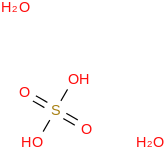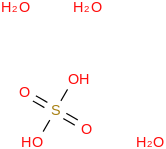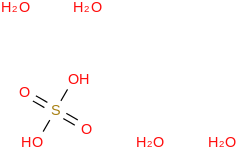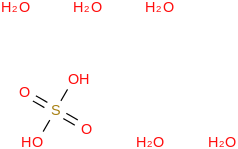Selected ATcT [1, 2] enthalpy of formation based on version 1.176 of the Thermochemical Network [3]This version of ATcT results[3] was generated by additional expansion of version 1.172 to include species related to Criegee intermediates that are involved in several ongoing studies[4].
|
Sulfuric acid dihydrate | | Formula: (OS(O)(OH)2)(H2O)2 (cr,l) | | CAS RN: 13451-10-0 | | ATcT ID: 13451-10-0*500 | | SMILES: OS(=O)(=O)O.O.O | | SMILES: [O-]S(=O)(=O)[O-].[OH3+].[OH3+] | | InChI: InChI=1S/H2O4S.2H2O/c1-5(2,3)4;;/h(H2,1,2,3,4);2*1H2 | | InChIKey: VCSZKSHWUBFOOE-UHFFFAOYSA-N | | Hills Formula: H6O6S1 | 2D Image: |  | | Aliases: (OS(O)(OH)2)(H2O)2; Sulfuric acid dihydrate; Hydrogen sulfate dihydrate; Dioxonium sulfate; (O2S(OH)2)(H2O)2; ((O2S)(OH)2)(H2O)2; ((SO2)(OH)2)(H2O)2; (S(O)(O)(OH)2)(H2O)2; (S(O)2(OH)2)(H2O)2; (H2SO4)(H2O)2; H2SO4.2H2O | | Relative Molecular Mass: 134.1100 ± 0.0063 |
| ΔfH°(0 K) | ΔfH°(298.15 K) | Uncertainty | Units |
|---|
| -1422.15 | -1426.94 | ± 0.14 | kJ/mol |
| Top contributors to the provenance of ΔfH° of (OS(O)(OH)2)(H2O)2 (cr,l)The 20 contributors listed below account only for 88.1% of the provenance of ΔfH° of (OS(O)(OH)2)(H2O)2 (cr,l).
A total of 27 contributors would be needed to account for 90% of the provenance.
Please note: The list is limited to 20 most important contributors or, if less, a number sufficient to account for 90% of the provenance. The Reference acts as a further link to the relevant references and notes for the measurement. The Measured Quantity is normaly given in the original units; in cases where we have reinterpreted the original measurement, the listed value may differ from that given by the authors. The quoted uncertainty is the a priori uncertainty used as input when constructing the initial Thermochemical Network, and corresponds either to the value proposed by the original authors or to our estimate; if an additional multiplier is given in parentheses immediately after the prior uncertainty, it corresponds to the factor by which the prior uncertainty needed to be multiplied during the ATcT analysis in order to make that particular measurement consistent with the prevailing knowledge contained in the Thermochemical Network.
| Contribution
(%) | TN
ID | Reaction | Measured Quantity | Reference | | 25.8 | 9416.1 | S (cr,l) + O2 (g) → OSO (g) | ΔrH°(298.15 K) = -296.847 ± 0.200 kJ/mol | Eckman 1929, note SO2 | | 17.0 | 9563.1 | S (cr,l) + 3/2 O2 (g) + H2O (cr,l) → OS(O)(OH)2 (aq, 115 H2O) | ΔrH°(298.15 K) = -143.85 ± 0.06 kcal/mol | Good 1960, CODATA Key Vals | | 12.5 | 9563.2 | S (cr,l) + 3/2 O2 (g) + H2O (cr,l) → OS(O)(OH)2 (aq, 115 H2O) | ΔrH°(298.15 K) = -143.92 ± 0.07 kcal/mol | Mansson 1963, CODATA Key Vals | | 6.7 | 125.2 | 1/2 O2 (g) + H2 (g) → H2O (cr,l) | ΔrH°(298.15 K) = -285.8261 ± 0.040 kJ/mol | Rossini 1939, Rossini 1931, Rossini 1931b, note H2Oa, Rossini 1930 | | 5.0 | 9602.1 | S (cr,l) + 3/2 O2 (g) + H2O (cr,l) → OS(O)(OH)2 (aq, 45 H2O) | ΔrH°(298.15 K) = -143.67 ± 0.11 kcal/mol | McCullough 1957a | | 3.4 | 9562.1 | S (cr,l) + 3/2 O2 (g) + H2O (cr,l) → OS(O)(OH)2 (aq, 70 H2O) | ΔrH°(298.15 K) = -143.58 ± 0.09 (×1.477) kcal/mol | McCullough 1953, CODATA Key Vals | | 3.1 | 9401.2 | 2 S (cr,l) → S2 (g) | ΔrG°(570 K) = 9.483 ± 0.138 (×1.915) kcal/mol | Drowart 1968, Detry 1967, 3rd Law | | 2.4 | 9401.4 | 2 S (cr,l) → S2 (g) | ΔrG°(600 K) = 8.57 ± 0.29 (×1.044) kcal/mol | Braune 1951, West 1929, Gurvich TPIS, 3rd Law | | 2.4 | 9563.3 | S (cr,l) + 3/2 O2 (g) + H2O (cr,l) → OS(O)(OH)2 (aq, 115 H2O) | ΔrH°(298.15 K) = -143.70 ± 0.07 (×2.278) kcal/mol | Waddington 1956, Mansson 1963, est unc | | 2.0 | 2373.7 | CH4 (g) + 2 O2 (g) → CO2 (g) + 2 H2O (cr,l) | ΔrH°(298.15 K) = -890.578 ± 0.078 kJ/mol | Schley 2010 | | 1.8 | 2375.1 | 2 H2 (g) + C (graphite) → CH4 (g) | ΔrG°(1165 K) = 37.521 ± 0.068 kJ/mol | Smith 1946, note COf, 3rd Law | | 1.7 | 9561.1 | OSO (g) + 1/2 O2 (g) + H2O (cr,l) → OS(O)(OH)2 (cr,l) | ΔrH°(298.15 K) = -231.329 ± 0.040 kJ/mol | NBS Tables 1989 | | 0.6 | 9565.1 | OS(O)(OH)2 (cr,l) → OS(O)(OH)2 (aq, 100 H2O) | ΔrH°(298.15 K) = -73.648 ± 0.040 kJ/mol | CODATA Key Vals, NBS TN270 | | 0.6 | 9566.1 | OS(O)(OH)2 (cr,l) → OS(O)(OH)2 (aq, 1000 H2O) | ΔrH°(298.15 K) = -78.356 ± 0.040 kJ/mol | CODATA Key Vals, NBS TN270 | | 0.4 | 9401.1 | 2 S (cr,l) → S2 (g) | ΔrH°(570 K) = 27.82 ± 0.67 kcal/mol | Drowart 1968, Detry 1967, 2nd Law | | 0.4 | 115.11 | H2O (g) → O (g) + 2 H (g) | ΔrH°(0 K) = 917.80 ± 0.15 kJ/mol | Thorpe 2021 | | 0.4 | 157.1 | OH (g) → [OH]+ (g) | ΔrH°(0 K) = 104989 ± 5 (×2.378) cm-1 | Wiedmann 1992, note unc | | 0.3 | 9401.5 | 2 S (cr,l) → S2 (g) | ΔrH°(298.15 K) = 31.20 ± 0.75 kcal/mol | Rau 1973a, Rau 1973, Gurvich TPIS, note unc3 | | 0.3 | 167.6 | H2O (g) → [OH]+ (g) + H (g) | ΔrH°(0 K) = 18.1183 ± 0.0015 (×1.067) eV | Bodi 2014 | | 0.3 | 152.1 | OH (g) → O (g) + H (g) | ΔrH°(0 K) = 35580 ± 15 cm-1 | Sun 2020 |
| Top 10 species with enthalpies of formation correlated to the ΔfH° of (OS(O)(OH)2)(H2O)2 (cr,l) | Please note: The correlation coefficients are obtained by renormalizing the off-diagonal elements of the covariance matrix by the corresponding variances.
The correlation coefficient is a number from -1 to 1, with 1 representing perfectly correlated species, -1 representing perfectly anti-correlated species, and 0 representing perfectly uncorrelated species.
| Correlation
Coefficent
(%) | Species Name | Formula | Image | ΔfH°(0 K) | ΔfH°(298.15 K) | Uncertainty | Units | Relative
Molecular
Mass | ATcT ID | | 99.1 | Sulfuric acid trihydrate | (OS(O)(OH)2)(H2O)3 (cr,l) |  | -1716.10 | -1720.21 | ± 0.15 | kJ/mol | 152.1253 ±
0.0064 | 40835-65-2*500 | | 98.8 | Sulfuric acid monohydrate | (OS(O)(OH)2)(H2O) (cr,l) |  | -1126.33 | -1127.48 | ± 0.13 | kJ/mol | 116.0948 ±
0.0062 | 10193-30-3*500 | | 97.1 | Sulfuric acid tetrahydrate | (OS(O)(OH)2)(H2O)4 (cr,l) |  | -2006.95 | -2010.99 | ± 0.17 | kJ/mol | 170.1406 ±
0.0065 | 37006-20-5*500 | | 95.0 | Sulfuric acid | OS(O)(OH)2 (cr,l) |  | -811.89 | -813.88 | ± 0.13 | kJ/mol | 98.0795 ±
0.0061 | 7664-93-9*500 | | 94.6 | Sulfuric acid pentahydrate | (OS(O)(OH)2)(H2O)5 (cr,l) |  | | -2300.39 | ± 0.18 | kJ/mol | 188.1559 ±
0.0066 | 137168-49-1*500 | | 92.7 | Sulfuric acid | OS(O)(OH)2 (aq, 1000 H2O) |  | | -892.23 | ± 0.13 | kJ/mol | 98.0795 ±
0.0061 | 7664-93-9*839 | | 92.7 | Sulfuric acid | OS(O)(OH)2 (aq, 100 H2O) |  | | -887.53 | ± 0.13 | kJ/mol | 98.0795 ±
0.0061 | 7664-93-9*828 | | 92.7 | Sulfuric acid | OS(O)(OH)2 (aq, 75 H2O) |  | | -887.18 | ± 0.13 | kJ/mol | 98.0795 ±
0.0061 | 7664-93-9*825 | | 92.7 | Sulfuric acid | OS(O)(OH)2 (aq, 7000 H2O) |  | | -899.22 | ± 0.13 | kJ/mol | 98.0795 ±
0.0061 | 7664-93-9*846 | | 92.7 | Sulfuric acid | OS(O)(OH)2 (aq, 50 H2O) |  | | -886.66 | ± 0.13 | kJ/mol | 98.0795 ±
0.0061 | 7664-93-9*822 |
| Most Influential reactions involving (OS(O)(OH)2)(H2O)2 (cr,l)Please note: The list, which is based on a hat (projection) matrix analysis, is limited to no more than 20 largest influences.
|
|
|
|
References
|
|
1
|
|
B. Ruscic, R. E. Pinzon, M. L. Morton, G. von Laszewski, S. Bittner, S. G. Nijsure, K. A. Amin, M. Minkoff, and A. F. Wagner,
Introduction to Active Thermochemical Tables: Several "Key" Enthalpies of Formation Revisited.
J. Phys. Chem. A 108, 9979-9997 (2004)
[DOI: 10.1021/jp047912y]
|
|
2
|
|
B. Ruscic, R. E. Pinzon, G. von Laszewski, D. Kodeboyina, A. Burcat, D. Leahy, D. Montoya, and A. F. Wagner,
Active Thermochemical Tables: Thermochemistry for the 21st Century.
J. Phys. Conf. Ser. 16, 561-570 (2005)
[DOI: 10.1088/1742-6596/16/1/078]
|
|
3
|
|
B. Ruscic and D. H. Bross,
Active Thermochemical Tables (ATcT) values based on ver. 1.176 of the Thermochemical Network (2024); available at ATcT.anl.gov |
|
4
|
|
T. L. Nguyen et al, ongoing studies (2024)
|
|
5
|
|
B. Ruscic,
Uncertainty Quantification in Thermochemistry, Benchmarking Electronic Structure Computations, and Active Thermochemical Tables.
Int. J. Quantum Chem. 114, 1097-1101 (2014)
[DOI: 10.1002/qua.24605]
|
|
6
|
|
B. Ruscic and D. H. Bross,
Thermochemistry
Computer Aided Chem. Eng. 45, 3-114 (2019)
[DOI: 10.1016/B978-0-444-64087-1.00001-2]
|
|
|
|
Formula
|
|
The aggregate state is given in parentheses following the formula, such as: g - gas-phase, cr - crystal, l - liquid, etc.
|
|
|
Uncertainties
|
The listed uncertainties correspond to estimated 95% confidence limits, as customary in thermochemistry (see, for example, Ruscic [5] and Ruscic and Bross[6]).
Note that an uncertainty of ± 0.000 kJ/mol indicates that the estimated uncertainty is < ± 0.0005 kJ/mol.
|
|
|
Website Functionality Credits
|
The reorganization of the website was developed and implemented by David H. Bross (ANL).
The find function is based on the complete Species Dictionary entries for the appropriate version of the ATcT TN.
The molecule images are rendered by Indigo-depict.
The XYZ renderings are based on Jmol: an open-source Java viewer for chemical structures in 3D. http://www.jmol.org/.
|
|
|
Acknowledgement
|
|
This work was supported by the U.S. Department of Energy, Office of Science, Office of Basic Energy Sciences, Division of Chemical Sciences, Geosciences and Biosciences under Contract No. DE-AC02-06CH11357.
|
|
Page generated: 04/23/2025
|







